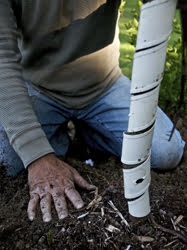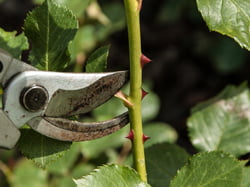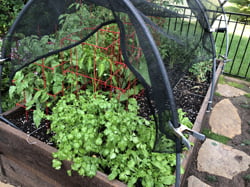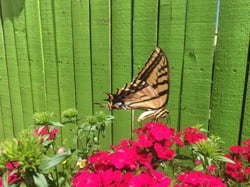By Jesse Eastman
I’m often a bit surprised when people come to the nursery looking for a definitive answer to a question. They can get frustrated and sometimes outright angry when they get different answers to the same question depending on which employee they speak with. While this is an understandable response, it’s important to recognize there are many reasons for this. The science of horticulture is constantly progressing and many issues which we’d like to believe are settled are often still highly debatable. Other times, what may seem like a hard fact to some may depend a lot more on personal taste than on right vs. wrong. Most often, though, it’s simply a matter of there being more than one way to do things while still ending up with a desired result.
Scientific Gray Area
 When it comes to the progress of science, there are several factors that hinder our ability to be in lockstep on a particular issue. One factor is simply incomplete information. When it comes to whether or not to remove the wire cage from a ball & burlapped tree’s root ball before planting, there are convincing studies done by exceptionally smart people that come down on both sides of the argument. On the one hand, there is a risk that the wires, left in the ground, may eventually interfere with root growth. On the other hand, the risk of wires damaging roots is very small, and the wire is often the only thing holding the root ball together. The process of completely removing the wire from a ball of soil that could weigh between 500-1000 lbs runs a high risk of damaging that root ball.
When it comes to the progress of science, there are several factors that hinder our ability to be in lockstep on a particular issue. One factor is simply incomplete information. When it comes to whether or not to remove the wire cage from a ball & burlapped tree’s root ball before planting, there are convincing studies done by exceptionally smart people that come down on both sides of the argument. On the one hand, there is a risk that the wires, left in the ground, may eventually interfere with root growth. On the other hand, the risk of wires damaging roots is very small, and the wire is often the only thing holding the root ball together. The process of completely removing the wire from a ball of soil that could weigh between 500-1000 lbs runs a high risk of damaging that root ball.
Another challenge is the self-correcting nature of scientific discovery. As our scientific understanding of a given topic grows, our practices must change. What you learned as a kid may no longer be valid in the face of new information. A great example of this can be found when you look at the history of soil amendment recommendations for new trees and shrubs. As recently as 10 years ago, we recommended that the soil used to backfill around a root ball when planting be comprised of 30-50% compost or other soil amendment. Since then, studies showed a much higher long-term success rate with only 15-20% amendment. The most current science supports eliminating soil amendment altogether in most cases, in spite of the short-term benefits of adding organic matter to the soil when planting. For a more in-depth explanation, read this article by Dr. Linda Chalker-Scott of Washington State University and The Garden Professors.
Fact vs. Opinion
 People generally like things to be black and white, right or wrong. In horticulture, however, the line between right and wrong is not always so clear, and many times not that important. Rose pruning is a perfect example. Here in Colorado, most roses will suffer some degree of winter die-back, leaving us with some branches in the spring that do not leaf out and must be pruned. While some gardeners prefer to preemptively prune their roses in the fall, others prefer to wait until spring. Experience shows that it does not make a significant difference in the overall longevity of the rose whether you prune in fall or spring, but the outcomes for each approach can have noticeable differences.
People generally like things to be black and white, right or wrong. In horticulture, however, the line between right and wrong is not always so clear, and many times not that important. Rose pruning is a perfect example. Here in Colorado, most roses will suffer some degree of winter die-back, leaving us with some branches in the spring that do not leaf out and must be pruned. While some gardeners prefer to preemptively prune their roses in the fall, others prefer to wait until spring. Experience shows that it does not make a significant difference in the overall longevity of the rose whether you prune in fall or spring, but the outcomes for each approach can have noticeable differences.
Fall pruning allows you to dispose of rose branches at the same time as all your other fall yard debris (and if you’re busy working in the spring like we are, you get as much done in fall as you can!) This can leave a much tidier looking landscape through the winter. However, because the plants may not have died back as far as they were pruned, they may be shorter next season than they would have if left to their own devices, albeit a little bushier and fuller.
If you choose to wait until spring, you can selectively prune only those branches that died back over winter. This requires a second round of debris disposal, but ensures you haven’t removed any wood that was sturdy enough to survive the winter. The plants may get a little taller, but may be leggier as well. As you can see, the trade-off is based on your personal taste – the rose will thrive either way.
Many Paths, One Goal
 Finally, we often give conflicting information because there is more than one way to accomplish the same thing.
Finally, we often give conflicting information because there is more than one way to accomplish the same thing.
You can grow delicious vegetables in raised garden beds, in containers, or directly in the ground. In-ground gardens require less materials to build, but drainage can be challenging and you’ve got a bit more work to do to make the soil nice and rich for vegetables. Raised beds and containers drain well and bring the garden up to you, so you don’t have to bend over as far to work the soil. You choose what soil to fill them with, so you can get good soil much more quickly. However, you’ve also got to build and/or buy the materials to build the raised beds or containers, so the initial cost may be higher. In spite of the sometimes dramatically different procedures involved in these various methods, the end result is still a big red juicy tomato!
 Plant selection is another arena where the end result may be the same, but the choices that got you there varied significantly. If you want to plant a pollinator garden, you can plant tons of annuals like dianthus, snapdragons, lantana, and more, or you can plant all perennials such as hyssop, bee balm, coneflower, and honeysuckle. If your goal is to feed pollinators, either option will be wonderful, but the process is very different. Your annual flowers can easily be swapped for something different next year if you’re not pleased with the results, because you’ll be replacing everything anyhow. Your perennial flowers may take a year or two to fill in and thrive, so there is more long-term commitment, but less work in subsequent years since those plants will survive the winter and pop up again next spring.
Plant selection is another arena where the end result may be the same, but the choices that got you there varied significantly. If you want to plant a pollinator garden, you can plant tons of annuals like dianthus, snapdragons, lantana, and more, or you can plant all perennials such as hyssop, bee balm, coneflower, and honeysuckle. If your goal is to feed pollinators, either option will be wonderful, but the process is very different. Your annual flowers can easily be swapped for something different next year if you’re not pleased with the results, because you’ll be replacing everything anyhow. Your perennial flowers may take a year or two to fill in and thrive, so there is more long-term commitment, but less work in subsequent years since those plants will survive the winter and pop up again next spring.
In this modern era of instant information, it is easy to get stuck in analysis paralysis. Too much information makes it hard to decide what to pay attention to and what to ignore, and that doesn’t even account for the flat out wrong information that seems so popular. Successful gardening depends a lot on recognizing and adjusting for regional differences, a fact which is all too often overlooked when researching gardening online. It also depends on being able to distinguish between two apparently opposing pieces of advice to determine what will be best for you and your particular project. A phrase I repeat often is “The best gardeners in the world have killed more plants than anyone else.” There is a lot of trial and error in learning to garden, and through that process we learn and grow. If you find yourself confused or lost in a sea of advice, don’t panic! Just remember, there’s probably a reason for every piece of advice. If you can find out the reason behind the information, you can decide what’s best for you, and find your own “right way.”
Originally published on August 1st, 2018. Updated on September 3rd, 2019.
